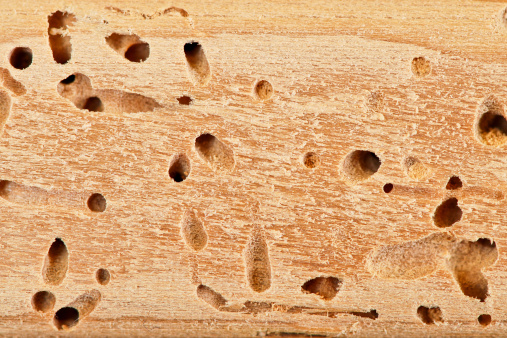Pest Control
How do you tell if you have a wood borers infestation?
Wood borer larvae – usually a creamy-white colour and curved in shape. Bore dust / frass – caused by emerging adult beetles, usually visible below the infested wood. Weak and damaged floorboards – in extreme cases, a foot or chair leg going through the floor can indicate a more serious problem. Wood-boring beetles can damage wood in and around a home or building. The adult beetles lay their eggs in cracks and holes in the wood and the larvae, or woodworms, eat their way out of the wood over several years. This can result in holes and tunnels in wood structures, outdoor decks, hardwood floors, furniture, and support beams. While powder post beetles, old house borer, common furniture, and other wood-boring beetles are beneficial in forests as they eat weak trees, they become a nuisance when they infest and damage homes and buildings.


What attracts wood borer?
Wood boring beetles are attracted to the moisture content in the wood, try to keep furniture, doors, and wooden items dry. Seal cracks and crevices on wood surfaces to deter wood borer from breeding. Remove infected wood to avoid the infestation from spreading to another area.
How do wood borer beetles spread?
- They actively fly in warm sunny weather.
- Within homes and other buildings, the furniture beetle is an exceedingly common pest.
- Despite its name this beetle can invade more than just furniture.
- Infestations can damage decorative woodwork, musical instruments, wooden tools and on a more serious scale wood flooring, joinery, and structural timbers.
- These wood boring beetles consume hardwoods and softwoods.
How do you tell if you have termites’ infestation
- Discoloured or drooping drywall.
- Peeling paint that resembles water damage.
- Wood that sounds hollow when tapped.
- Small, pinpoint holes in drywall.
- Buckling wooden or laminate floorboards.
- Tiles loosening from the added moisture termites can introduce to your floor.
- Excessively squeaky floorboards.
Identification factors for subterranean termites are: Alates (swarmer’s): Dark brown to black in color, about ¼ to ½ inch long with two pairs of wings that are very close to being equal in length. Workers: No wings, about ¼ inch or less in length and cream colored.
How can you tell the difference between drywood and subterranean termites?


The main difference between these two is that drywood termites infest dry wood and do not require contact with the soil, while subterranean termites need contact with soil or water to survive.
What attracts termites?
Leaky pipes, improper drainage, and poor airflow all create moisture issues that attract termites. Damp wood and subterranean termites thrive in humid environments. While damp wood termites prefer water-damaged wood, subterranean termites are unable to live unless surrounded by enough moisture.
Termites take a very short time to spread. Within a few days, they can multiply to what’s considered an infestation. Homeowners need to take every percussion possible and be sure to act quickly to protect their homes.
Services offered:
Allrid Pest Management perform inspections for Beetle / Termite Free Compliance Certificates for domestic or commercial properties. In case of an unfortunate event where an infestation is present, we can assist with a quotation and correct wood and soil treatment procedures. Our services are available to Real Estate Agents, Developers and the Private Sector.
Allrid Pest Management have registered and trained professionals with knowledge of the habits and lifecycle of wood borer and termites. By following the PEST approach as part of our integrated pest management, we ensure an effective protection for your business by the use of the correct treatment to get rid of wood borers / termites for your individual circumstances.
